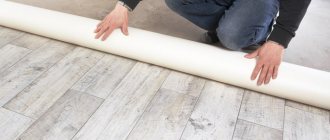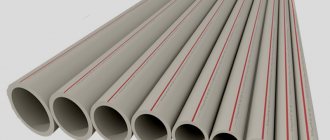A part such as a siphon is made of various materials. The most popular options today are plastic and metal. Of course, plastic parts are cheaper and more common, but stainless steel siphons last longer and are less susceptible to mechanical damage.
Today in plumbing stores you can find not only standard manual siphons, but also automatic and semi-automatic siphons. According to consumers, using such products is more convenient. The main thing is to choose a suitable model with a reliable and durable automatic mechanism.
Modern siphons are distinguished by a wealth of choice. The range of these parts allows you to choose an ideal and durable copy that will serve without causing any problems.
Installation of bath siphons
The design of most siphons consists of two parts: 1) drain block; 2) overflow block.
- The drain pipe is used for direct drainage of water and is attached to the bottom of the bathtub bottom.
- The overflow block serves to protect against water overflowing over the edges of the bathtub, so the pipe opening is located on top not far from the edges.
A bathroom drain using a siphon ensures proper water circulation and also blocks unpleasant odors from the sewer. This design has 4 parts: a neck, a pipe, an overflow corrugated hose, a soft or hard pipe that directly connects to the sewer.
The neck is directly attached to the bottom of the bathtub on both sides using a metal screw, which tightly tightens the inner and outer parts. During installation, it is important to ensure tightness using a rubber seal. The overflow neck has a side outlet through which water flows in a stream under low pressure.
The siphon pipe has a curved shape, which ensures that a certain amount of water is always inside. This water barrier prevents the movement of odors from the sewer system. To effectively perform these functions, the volume of liquid must be at least 300-400 ml, since with a small volume of water it can be automatically sucked into the sewage system.
The corrugated hose drains excess water, preventing possible overflows from the top. However, due to the low pressure of liquids, it is not necessary to use crimp structures.
The connection to the sewer can be made using more reliable hard or soft corrugated tubes, which can be adjusted in length.
When assembling a complete structure, flat or conical gaskets, screws and union nuts are used. It is important to consider that the thinner part of the gasket should go into the adjacent pipe towards the sewer.
Today, the sanitary equipment market offers drainage structures for individual baths in three main varieties:
- conventional mechanical system with plug;
- semi-automatic bath siphon;
- automatic connection for bathtub.
↑ 1. Operating principle
The piping (or drain-overflow) organizes the drainage of water from the bathroom tank into the sewer pipe. The device consists of several hoses and tubes that are connected to each other, with a sewer system and two bath openings. The top hole of the tank prevents water from overflowing, the bottom hole is responsible for draining.
If all components are installed correctly, the likelihood of overflowing the bathtub is reduced to a minimum, but there must be moderation in everything. Sometimes water fills the bowl faster than it drains, in which case you can flood the floor in the room.
Types of siphons depending on design
Depending on the design, there are the following types of these products.
Flat. The design of such a device allows for their installation in limited space. The main part of the device, in which a water seal is formed and debris accumulates, is located horizontally. In order to clean the flat bath siphon, it is necessary to partially dismantle it.
Flat siphon - ideal for installation in confined spaces
Pipe. Such devices are made from pipe sections of different lengths, joined in a certain sequence. Pipes in this design have sufficient rigidity. This bathroom siphon is more compact than the previous type, however, due to the lack of a compartment in which debris is concentrated, cleaning it is more difficult.
Bottled. This type is distinguished by the presence of a special compartment, which is shaped like a bottle (hence the name). Garbage is collected in this compartment, and there is also a water seal in it. Bottle siphons are quite large in size compared to other types, so their installation is only possible if there is enough free space under the bathtub. Such devices can be periodically cleaned without completely disassembling the structure, which is very convenient.
Corrugated. They are distinguished by the simplest design, which includes a “drain-overflow” type device and a soft pipe.
The pipe can be bent in any desired direction. A corrugated siphon for a bathtub has one drawback - the rapid formation of a blockage. This is due to the fact that the ribbed walls trap foreign particles. In addition, connecting the overflow element often causes difficulties.
Technical features of the system
Bathroom waste and overflow
The design of the drain and overflow consists of pipes tightly connected to each other and ensuring the necessary tightness. When water reaches the corresponding opening in an uncontrolled flow, the excess flows into plastic or flexible hoses and goes through the sewer pipe. A corrugated tube is a practical option, since in a small room area it bends and extends in any direction. The device is equipped with a siphon to protect the bathroom from unpleasant odors emanating from drainpipes.
External parts of the system are made of stainless or galvanized steel, which corresponds to its high quality and durability.
When purchasing a system, you should pay attention to the high-quality execution of all elements and mechanisms, as well as the presence of special seals and cuffs. If they are absent during operation, serious leaks often occur due to insufficient tightness of pipe connections. They can be purchased separately according to the diameter of the coupling or pipe.
Today there is a wide range of bath drains, the prices of which depend on the technical features, material and configuration. Manufacturers produce standard plastic versions, as well as models made of expensive metals with applied ornaments or engravings. There are the following types of drain-overflow systems:
- regular siphon with plug;
- semi-automatic system;
- automatic drain mechanism.
A certain type has advantages and disadvantages, but their use depends on the design features and individual needs.
Types of siphons according to the method of water discharge
There are the following types of siphons according to the method of water discharge:
- manual;
- semi-automatic;
- automatic.
Automatic siphons are complex devices, but they make it easier to control the water level in the bathtub
Manual. The design of such devices is considered the simplest. These devices are equipped with a drain hole that is manually adjustable (opens and closes).
Semi-automatic. Semi-automatic devices at the manufacturing stage are equipped with a special plug with an additional cable. This plug is adjusted using a handle located outside the bathtub. As a rule, such a handle has two positions: directly draining water from the bathtub or placing a load on the overflow hole.
Automatic (click-clack devices). Such devices are the most complex in terms of execution. The automatic bathtub is able to independently regulate the water level in the bathtub bowl. In order to drain the water, in this case you just need to press the drain lid.
Important! Experts do not recommend installing automatic models yourself. This is due to the fact that their installation requires special knowledge and high precision, otherwise such a system will be ineffective.
Materials used for the manufacture of siphons
For the manufacture of siphons the following are used:
- plastic. Plastic devices are durable and low cost. It is optimal to install such equipment on a bathtub with a protective screen, since the appearance of the device is not aesthetic;
- metal: brass, bronze, chrome steel and so on. Metal siphons are suitable for acrylic bathtubs, especially those installed in the center of the bathroom. The devices, having an elegant and neat appearance, can serve as additional elements of room decor;
Siphon made of copper and brass
- cast iron. Siphons made of cast iron are intended exclusively for bathtubs made of the same material. Currently, they are practically not used, as they are large in weight and size, and also require high installation accuracy.
Device made of cast iron
If the siphon is not visible to users, then it is enough to install a plastic device.
Bath Siphon Manufacturers
The best bath siphon is a high-quality device manufactured in compliance with all norms and regulations. It is more advisable to purchase siphons from well-known manufacturing companies that can guarantee the quality and long service life of the products. Such companies include:
- Geberit (Switzerland). The company, which began its activities in 1874, remains a leader in the plumbing market to this day. The organization's employees are constantly developing and implementing the latest devices necessary for a high standard of living for consumers. Products from the manufacturer are quite expensive, but have a high level of quality.
Installed Geberit siphon with PushControl system
- Ani plast (Russia). The company is a leading Russian manufacturer of plastic plumbing fixtures. Products manufactured by the company are annually certified and quality tested. The products are low in cost.
- Viega (Germany). The quality of products is controlled at all stages of production, starting with the supply of materials. All siphons are certified. The cost of the products is quite high, but the economic costs are justified by the long service life.
The video provides an overview of a semi-automatic siphon from Viega.
Rating of the best manufacturers
In order not to get into trouble and not suffer with a problematic product of dubious quality, you should purchase products from well-known and trusted European companies. They produce equipment according to generally accepted international standards and norms.
Geberit . A high-quality Swiss brand with a wide range of products at mid-range prices. The product is easy to use and adapts well to non-standard sizes.
Most designs have an adjustment plug near the overflow hole that opens the drain plug
Alcaplast . One of the largest manufacturers of sanitary ware in Eastern and Central Europe. The Czech brand produces devices with a special design and simple construction, which stably and silently perform their functional tasks throughout their entire service life, regardless of the influence of aggressive environmental factors.
Kaiser . Manufacturer from Germany, producing trims for modern bathtubs. The company's products allow you to adjust the length of the siphon over a wide range, which makes it possible to easily install it, including in deep bowl models.
Viega . A German company that has established itself in the market as a manufacturer of safe plumbing products of the highest quality that can last about half a century. They successfully combine design and engineering ideas.
The assortment includes drain-overflow systems with different shapes, materials, and color variations. They are characterized by a relatively low price and simple installation.
Many Viega models have a water filling function. They are convenient for rooms where there is not enough space to install a faucet.
Hansgrohe . Another representative of good German quality. The company's harnesses are reliable, efficient, and feature a complex, high-tech structure. In interiors they are valued for their functionality and excellent decorative performance.
We install a drain in the bathtub
The kit for the bathtub siphon must include instructions that indicate how to properly install the siphon in the bathroom or, at a minimum, what the assembled siphon you purchased looks like. These instructions are kindly provided by the manufacturer. The assembly of classic and semi-automatic siphons is not much different from each other, but some nuances still exist and cannot be neglected.
If the device you purchased is intended to replace an existing one, then make sure that the attachment points of the previous siphon are cleared of sealant residues and the abutment surfaces are cleaned. Such measures are necessary to prevent leakage of new gaskets at their installation sites.
Assembling a modern plastic siphon with your own hands is not at all as difficult as it might seem at first glance. Having opened the box with the siphon, do not rush to get scared and call a specialist. You will do everything very well on your own.
First stage of installation
Our first task is to attach the bottom drain to the tub. Take this pipe, put a gasket in it, and then place it from the bottom to the drain hole. Install a protective grille on the opposite side of the hole in the bowl itself and tighten the connection with a screw.
Now you need to check the holes for alignment and make sure that the gasket is not warped. If this is not done, a leak may occur after tightening the screw. After making sure that everything is in order, tighten the screw while holding the lower pipe with your hand.
Second stage of installation
Now you should install the upper overflow pipe. In this case, you need to proceed in the same way as when installing the lower drain pipe. The upper pipe is also tightened with a screw. The only difference is that it is better to turn this pipe slightly in the direction from the wall to the door to make it easier to manipulate its connection with the corrugated drain pipe.
The pipes of both drain holes are connected by a corrugated tube. If it turns out to be too long, it should be curved rather than cut. If a nut is involved in the process of connecting two pipes, then it is the nut that must be placed on the corrugation first. Then comes the laying turn, after which the connection is made.
Third stage of installation
Now you need to check the “elbow” of the drain siphon, in which a water seal will be formed. There should be no defects where the gaskets are attached. The water seal must be absolutely sealed, otherwise it will not perform its main functions.
The “elbow” fastenings are the same for almost all siphon models. This is a union nut with a conical or flat rubber band. The “elbow” is connected to the corrugated tube using a union nut and gasket.
Fourth stage of installation
At the fourth and final stage, the system should be connected to the sewer drain. There are only two mounting options here. If your bathroom still has old cast iron pipes installed, the connection should be made using a sealing collar.
If the bathroom is equipped with new plastic pipes, then it is enough to make a direct connection into the pipe. You don't need any additional devices for this.
To visualize what the siphon elements should look like and how to assemble a plastic bath siphon, watch this video:
So, when the installation of the siphon is already completed, you can begin testing. To do this, you need to fill the bathtub with water and check for leaks with the drain plug closed. If it is dry under the bathtub, then we can assume that the lower pipe is correctly connected to the drain hole. All that remains is to pull out the plug and make sure that the water leaves the bowl without leaks throughout the drainage device.
Checking the quality of installation of the drainage device and searching for possible leaks is a mandatory event that will allow you to be sure that you will not flood yourself and your neighbors below
If you find a leak, disassemble the problem area and determine the cause of the problem. This could be a skewed gasket, a poorly tightened nut, or interference at the joints. Once the problem has been resolved, perform the test again.
How to install the drain mechanism yourself?
What do you need to know to install it yourself?
First, you should carefully read the instructions and all documentation included with the kit: all installation recommendations must be strictly followed, otherwise the mechanism will not work correctly or will not work at all.
An important installation point is that the hole for the drain should not be lower than fifteen centimeters from the surface on which the bathtub itself is installed.
Pay attention to the stability of the container - the bathtub should not wobble, especially for acrylic and metal bowls, which have little weight and, as a result, poor stability.
Then a special tee should be attached to the decorative grate of the drain hole. The connection is carefully treated with sealant or additionally covered with gasket material. The siphon is mounted on the lower end of the tee, and a connecting tube is attached to its side.
The next stage of installation work is to attach an angle to the tee, which will connect the mechanism to the sewer. Do not forget that each connection in the installation of an overflow drain requires treatment with a sealant and mandatory inspection before drawing water. To do this, you need to fill the bowl with a little water and then perform a test drain. If there is no water leakage, the mechanism is installed correctly and is ready for operation.
Metal drains should be installed carefully and without sudden movements - they are not very flexible and can burst if bent too much.
Design characteristics of semi-automatic
The semi-automatic bath fitting has a rather complex design, which is characterized by an additional shut-off valve controlled by a lever on the overflow hole. It can be made in the form of a button, a decorative valve, or a rotary ring. Control occurs using a system of cables and other additional connecting parts. The advantages of such a siphon lie primarily in convenience and comfort of use. The closed overflow device has a high aesthetic appeal.
On the other hand, the complexity of the design and the presence of many moving parts reduce the reliability of such systems.
When purchasing siphons of this type, it is important to pay special attention to manufacturers of high-quality fittings for sanitary equipment that have proven themselves well. The durability and uninterrupted operation of these drains directly depends on this.
Installation of drain-overflow systems
Semi-automatic and automatic devices differ from conventional ones by the presence of special mechanisms that open and close the drain hole using a valve rather than a removable plug. When installing one or another system, the height of the bathroom drain is at least 15 cm. The semi-automatic device is equipped with a stylish control unit made of metal. When turned, the chrome ring tightly closes the drain using a closing element.
The automatic system features an improved mechanism consisting of a spring-loaded moving part and a button. The first element has the function of fixing in a closed or open state, thereby blocking the drain hole after pressing the button. The advantage of a semi-automatic device is that it opens the drain without having to put your hand in the water. The automatic device allows you to control the position of the valve not only with your hand, but also with your foot, which makes it practical to use.
Features of automatic siphons
Thanks to technological progress, an improved siphon for a modern bathtub has appeared on the sanitary equipment market, working like an automatic machine. Automation provides a large selection of operating modes and additional functions. With a single turn of the knob or pressing a button, water is drawn to the desired temperature.
In this case, it is possible to maintain a certain water temperature for a certain period of time. The automatic siphon is made of brass and copper alloys, which are coated with a layer of chrome to attract external shine and chic, and also repel dirt and provide reliable protection of materials. The system is equipped with a “click-clack” valve, which greatly facilitates control due to the absence of any additional levers and handles.
Along with undeniable advantages, such drains during operation require uninterrupted electrical power and regular maintenance. In addition, automatic siphons have a fairly high cost and are also characterized by frequent breakdowns. Moreover, even the failure of a small spring requires replacement of the entire structure.
Thus, in order to choose the most optimal siphon for a bath, it is better to study in detail the statistics and nuances of the operation of certain models, look at reviews about the manufacturer and design. When choosing a particular model, great attention should be paid to reliability and durability, since drains perform invisible work, exposed to hot, cold water, and various detergents.
Types and principle of operation of equipment
The overflow drain removes used liquid and prevents the bowl from overflowing due to uncontrolled water supply. The structure provides two holes - at the bottom and in the wall of the bathtub. They are supplied with interconnected hoses connected to the sewer drain.
Features of mechanical devices
There are three options for drain and overflow systems on sale. The difference between them lies in the method of removing the plug blocking the drain hole. If you are planning to buy a bathtub drain and overflow and are not sure which one is better to choose, you should pay attention to the model of your bathtub and its location in the room.
The simplest type of device is determined by the traditional design, found in almost every apartment. It has no moving components or levers. Water is drawn in when the plug is closed, and released when it is opened.
Mechanical products rarely break down and last a long time. The plug is attached to the drain grate on a chain, removed and placed in the opening manually
Products in this category differ in the type of connection to the sewer, sealing of connections, and the shape of the pipe. Devices include the following elements:
- Drain neck . Installed in a hole made in the bottom. It consists of a chrome funnel that “catches” large particles of debris, and an expanding pipe with a built-in nut. The parts are joined with a reinforced metal screw. A rubber ring seal is responsible for the impermeability.
- Overflow neck . Inserted into the wall of the bathtub. The design is similar to a drain, but is adjacent to the general contour of the network through a lateral, rather than direct, drainage system.
- Siphon . An arched removable pipe designed to act as a water seal. Blocks attempts of unpleasant sewer odors to enter the bathroom. Connects mechanisms with each other and with the sewer network. Available in a variety of configurations. Models with a deep shutter that holds at least 300 ml of liquid are considered optimal.
- Connecting corrugated tube . Diverts water entering the overflow to the siphon. Connects to other components with pipes.
- Auxiliary pipe - soft or hard. Provides drainage from the siphon into the sewer pipe.
The kit also includes connecting parts that increase the tightness of the system. These are flat and conical gaskets used together with a union nut. Conical products are mounted from the nut with a sharp edge so that the thin part goes inside the opposite element.
Devices not equipped with mechanisms are produced in universal sizes and are designed for bathtubs with an average distance from the center of the overflow to the drain not exceeding 57.5 centimeters
Advantages of manual strapping: budget price, simplest assembly/installation algorithm, rare breakdowns, reliability. Among the disadvantages, rapid wear of the seals should be noted.
Characteristics of semi-automatic devices
A later modification of the traditional design is a semi-automatic system. It contains the largest number of components. It is supplemented by a control unit that raises/lowers the plug, a shutter valve, and a cable that controls its position.
The control unit is implemented in the form of a handle, valve, rotary ring, button. You can operate it by turning the lever 90 degrees or pressing a button without bending over to the bottom of the bathtub. Thus, the shut-off rod rises and falls, opening or closing the valve
The system is activated by tightening and releasing an auxiliary cable located inside or outside the overflow pipe. The first option looks more aesthetically pleasing, but is much more difficult to repair.
Advantages of semi-automatic machines:
- Convenience of closing the drain (without having to bend over or wet your hands);
- comfortable management and operation;
- stylish design.
The disadvantages of the device include a complex structure with a mass of moving and connecting components and the risk of the cable jamming over time. In semi-automatic systems, the overflow holes are hidden behind the control unit. Visible details perform a decorative function in the interior thanks to a thoughtful design.
What are the benefits of automatic drains and overflows?
A distinctive feature of automatic systems is their complex structure with a click-clack valve button, equipped with a latch and a built-in spring.
In automatic systems, the button, as in mechanical ones, is operated manually (or by pressing the heel of the foot while in the shower). When pressed, the plug lowers, closing the drain opening. If you repeat the manipulation again, it rises, starting the drainage of water
The buttons are designed in elegant high-tech, modern, and retro design styles. They are made from brass and copper, coated with chrome or nickel plating.
Advantages of automated devices:
- ergonomics and presentable appearance;
- compactness;
- convenient drainage.
There are also many disadvantages: the high cost of the proposals, the vulnerability of the spring holding the valve, difficulties in replacing the button, painstaking installation, often requiring professional intervention.
The automatic drain can be equipped with the functionality of collecting water. It is considered if it is impossible to rationally place a faucet in the bathroom.
The diagram includes pipes for the liner, which are connected to the overflow hole. The bowl is filled through the top connector, which eliminates flooding, since the flow automatically stops when there is an excess of water.
In addition to the usual types of fittings, there are separate products adapted to the characteristics of specific bathtub models
Siphon care
To ensure the durability and high performance of this plumbing fixture, it must be properly cared for. The bathtub siphon should be inspected regularly for leaks or mechanical (physical) damage.
Recommendations for caring for the siphon:
- To avoid the accumulation of scale and other deposits on the walls, you need to flush the siphon with hot water and citric acid at least once every few months. You can also use special chemical cleaners (suitable for the material of your device). It could be “Phlox”, “Ruff” and others;
- On average, every 6 months, rubber gaskets lose elasticity and become thinner. If the siphon begins to drip, this is a sure sign that it is time to replace them;
- To prevent the drain in the bathroom from becoming clogged, you need to periodically clean the water seal. This is the place where water and various contaminants (hair, for example) collect. To do this, the water is shut off, the siphon is disassembled “up to the knee” and cleaned. Afterwards, the joint must be treated with sealant and wait for it to dry;
- If cracks or chips are found during the next inspection, then the siphon needs to be replaced. Such faults cannot be repaired and pose a real danger of flooding the apartment.
Selection rules
Choosing a siphon is quite difficult, since it is presented in a huge number of types, differing in design, functions performed, material of creation and other parameters. In the selection process, the method of fastening the product must be taken into account, and this is especially true if you plan to do the installation work yourself.
The simplest installation is considered to be one that uses bolts to secure metal outlets. However, removing the pipes for cleaning will be difficult, and all metal parts are subject to corrosion. If you plan to create a room in a certain unique style, then you often choose a special frame for the overflow washbasin that matches the design.
During the selection process, it is important to check that the kit includes all the necessary elements for installation and operation of the product. It is advisable to take into account important factors when selecting a model:
- there must be a grate covering the drain and overflow, which will provide protection against various foreign objects entering the sewer;
- the kit must certainly include a plug that covers the drain hole, and it can be made of plastic or rubber, and is also fixed to the overflow with a chain;
- the manufacturer of the product is taken into account, since it must be reliable and proven;
- the material from which the structure is made must be ideally suited for the bathtub itself or other plumbing fixture, and must also be of high quality, durability and resistance to numerous exposure factors found in the bathroom;
- cost is also considered an important parameter for many buyers, and automatic designs are considered the most expensive, so they are usually installed in bathrooms designed in a luxurious and unique style;
- parameters of the bathtub or sink for which the product is selected, since installation can be simple and quick only if both elements match perfectly.
It is not recommended to purchase siphons equipped with components made of hard materials, as this significantly complicates the installation process, so flexible tubes are considered optimal.
Thus, the process of choosing a high-quality siphon for any plumbing fixture is an important point in increasing the comfort of water procedures. It is presented in several varieties, differing in design, material of creation and other parameters. In the selection process, it is recommended to take into account the advice of experts in order to get a truly high-quality and durable product that copes well with its main tasks.
Required materials and tools
To change the drain device, you will need a minimum set of tools consisting of a screwdriver, pliers and a wrench.
Before starting work, the completeness of the factory delivery of the sanitary siphon is checked, including:
- frame;
- drain pipe;
- decorative grille masking the drain;
- cuffs made of rubber and polymers;
- fastening hardware (bolts and nuts);
- elastic gaskets for sealing joints.
If one or more items are missing, the missing parts must be purchased separately.
In addition, high-quality installation work is impossible without additional materials:
- tow or rags;
- sealing composition based on silicone or rubber;
- FUM tapes.
When dismantling, you will need a container to drain the water. A large bucket or basin will do.
Doesn't work well: what to do?
Over time, many users encounter poor performance of the siphon and the entire drainage system as a whole. The causes of such problems may lie in improper installation of all components of the structure or in clogged pipes.
Mechanical blockages
Mechanical blockage of pipes can be caused by sand and pebbles from shoes, animal hair, human hair and many other similar little things getting into their interior. All these components certainly lead to serious blockage of both the pipes and the siphon itself. Because of this, the water from the bathtub usually drains very poorly and slowly.
This problem can only be resolved by thoroughly cleaning the pipes. However, in order to avoid such events, it is worth installing a special fine mesh on the drain hole, which will prevent foreign particles from entering the pipes and siphon.
Operational
Such blockages usually result from simple improper use of the bathtub. In this case, clogging of the pipes and siphon may occur due to dirt and particles that should remain on the protective mesh, but, unfortunately, not everyone uses it. In addition, a combination of grease and cold water often leads to operational blockages.
Technogenic
Water may not drain well due to an inexperienced technician who made many mistakes while renovating the bathroom in your home. Or maybe the fact is that the installation or replacement of plumbing in the room was not carried out according to technology. For example, you could have chosen the wrong level for installing objects or made the wrong drainage slope as it should be.
To get rid of these problems, you need to either dismantle the plumbing (if it is installed incorrectly) or remove blockages that have accumulated in the pipes.
- Thoroughly clean the siphon and drain - these are the main and vulnerable places where garbage collects first. To do this, you need to remove the siphon and unscrew the protective mesh behind it. Please note that this must be done with both the bathtub and the sink in the room.
- Now shake out all the removed parts into the toilet.
- Then thoroughly rinse the siphon, completely free of contaminants, and with it all tubes, bowls, gaskets and protective mesh.
- Wash all parts with a brush and a high-quality cleaning agent that has a degreasing effect.
- Do the same with the mesh located on the sewer openings - these are the central areas where blockages accumulate.
- Clean the corrugations that lead directly to the sewer.
You can also clean pipes and corrugations mechanically. While the external elements of the drain are drying, mechanical devices should be used to clean the system. For this purpose, a cable with a handle is most often used. It should be screwed into the depth of the sewer, trying to lower it as low as possible. After this, you need to remove the cable and repeat the work done. It is advisable to do this several times to be sure of the ideal frequency of the pipes.
Next, you should move on to chemical sewer cleaning. To do this, it is necessary to pour chemical compounds into the sewer that are designed directly to break down fats and soften plaque. There are quite a lot of such funds. Some of the most popular are products such as “Mole”, “Tone”, “Tiret” and others. It is recommended to leave these products on for 15-20 minutes. Some wait a little longer than 40-50 minutes. After the required amount of time, you should turn on the water in the bath for 10-15 minutes to remove all aggressive chemicals.











